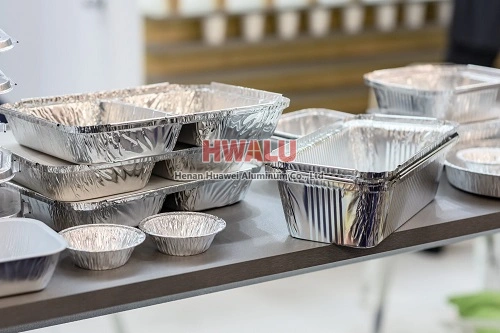What is aluminum foil for bowls Aluminum foil for bowls refers to a kind of aluminum foil material used to cover food in bowls. It's usually a sheet of aluminum foil that wraps easily around the bowl and keeps food fresh and warm. Aluminum foil for bowls is commonly used for storing and heating food and can be used in the microwave or oven. There are multiple benefits to using aluminum foil for bowls, it can ...
Honeycomb Aluminium foil Details Typical alloy 3003 5052 Temper O,H14, H16, H22, H24, O、H12、H14、H16、H18、H19、H22、H24、H26 Thickness (mm) 0.005-0.2 0.03-0.2 Width (mm) 20-2000 20-2000 Length (mm) Customized Treatment mill finish payment method LC/TT what is Honeycomb aluminum foil? Honeycomb aluminum foil has the advantages of light weight, high strengt ...
What is aluminum foil for stickers Aluminum foil is a flexible, lightweight material perfect for making stickers. You can use aluminum foil for decorations, labels, stickers, and more, just cut out and add adhesive. Of course, stickers made of aluminum foil may not be as durable as stickers made of other materials, because aluminum foil is prone to chipping and tearing. Also, you need to be careful when using ...
What is 5052 alloy aluminum foil? 5052 aluminum foil is a common aluminum alloy material, which is composed of aluminum, magnesium and other elements, and has the characteristics of medium strength, good corrosion resistance and weldability. It is a common aluminum alloy material for industrial use, usually used in the production of fuel tanks, fuel pipelines, aircraft parts, auto parts, building panels, etc. 5 ...
What is Aluminum Foil for Electricians Electrical aluminum foil is a special type of aluminum foil that is coated with an insulating material and is commonly used in electrical insulation applications. Its insulating layer prevents the loss of current from the surface of the aluminum foil while protecting the foil from the external environment. This aluminum foil usually requires high purity, uniformity, a ...
After printing and coating, aluminum foil paper and cash register paper need to be post-printed and slit on a slitting machine to cut large rolls of semi-finished products into the required specifications. The semi-finished products that run on the slitting machine are an unwinding and rewinding. This process includes two parts: machine speed control and tension control. The so-called tension is to pull the al ...
The aluminum foil disposable lunch box has excellent oil and water resistance and is easy to recycle after being discarded. This kind of packaging can quickly reheat the food and keep the fresh taste of the food. 1. Performance of aluminum foil tableware and containers: All kinds of food lunch boxes produced by aluminum foil, aviation lunch boxes currently generally adopt the latest and most scientific alum ...
ITEM SIZE (MM) ALLOY / TEMPER WEIGHT (KGS) ALUMINIUM FOIL, ID: 76MM, ROLL LENGTH: 12000 - 13000 meters 1 0.007*1270 1235 O 18000.00
1. Wide moisture-proof waterproof: Aluminum foil tape has the performance of moisture-proof, waterproof, oxidation, etc., which can effectively protect the adhesive items and prevent them from being eroded by moisture and water vapor. 2. Innidity insulation: Aluminum foil tape has good thermal insulation performance, can effectively prevent heat transmission and is suitable for thermal insulation of pipelines, ...
The thickness of aluminum foil for food packaging is generally between 0.015-0.03 mm. The exact thickness of aluminum foil you choose depends on the type of food being packaged and the desired shelf life. For food that needs to be stored for a long time, it is recommended to choose thicker aluminum foil, such as 0.02-0.03 mm, to provide better protection against oxygen, water, moisture and ultraviolet rays, th ...
Aluminum foil lunch boxes made of aluminum foil can be processed into various shapes and are widely used in food packaging such as pastry baking, airline catering, takeaway, cooked food, instant noodles, instant lunch and other food fields. The aluminum foil lunch box has a clean appearance and good thermal conductivity. It can be heated directly on the original packaging with ovens, microwave ovens, steamers and ...







